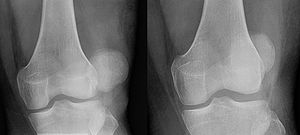
Patellar luxation

A luxating patella, or trick knee in layman's terms, is a condition in which the patella, or kneecap, dislocates or moves out of its normal location. A luxating patella, or trick knee in layman's terms, is a condition in which the patella, or kneecap, dislocates or moves out of its normal location. Patella luxation is a common condition in dogs, particularly small and miniature breeds. The condition usually becomes evident between the ages of 4 and 6 months. It can occur in cats, as well, especially domestic short-haired cats. It also occurs in humans, where it can be associated with damage to the anterior cruciate ligament. Most cases of patellar luxation are medial, and this is frequently a congenital problem in toy- and miniature-breed dogs. Breeds showing a predisposition for medial patellar luxation include miniature and toy Poodles, Maltese, Jack Russell Terriers, Yorkshire Terriers, Pomeranians, Pekingese, Patterdale Terriers, Chihuahuas, Cavalier King Charles Spaniels, Papillons, Boston Terriers, Plummer Terriers, and Teddy Roosevelt Terriers. Large-breed dogs are also affected, and the Labrador retriever seems particularly predisposed. Patellar luxation is less common in cats than in dogs. Predisposed breeds include the Devon Rex and the Abyssinian. Although the specific cause of patellar luxation is unknown in these cases, a defect in hind limb conformation is generally agreed to be the underlying cause. Rarely, it can be caused by some form of blunt trauma, but most frequently, it is a developmental, congenital defect. In congenital cases, it is frequently bilateral. The condition can also be inherited through genetics. This can also be caused by obesity. Diagnosis is made through palpation of the knee, to see whether it slips inside the joint more than would normally be expected. Often, a dog owner might be told that his or her pet has 'loose knee', but this is not a medical term, and it is not correct to use it interchangeably with luxating patella. Luxating patella cannot be present without the knee being loose, but a loose knee is not necessarily slipping out of the joint. Even with luxating patella, symptoms such as intermittent limping in the rear leg might be mild or absent. Physical examination and manual manipulation are the preferred methods for diagnosis. More extreme cases can result in severe lameness. Osteoarthritis typically develops secondarily. The four recognized diagnostic grades of patellar luxation include, in order of severity: Grades II, III, and IV require surgery to correct, if the animal has difficulty walking. The surgery required is governed by the type of abnormality present, but often involves a , a deepening of the trochlear sulcus where the patella sits, a realignment of the attachment of the patella tendon on the tibia, and tightening or releasing of the capsule on either side of the patella, according to which side the patella is slipping. Some grade IV conditions may require more involved surgery to realign the femur and/or tibia.
